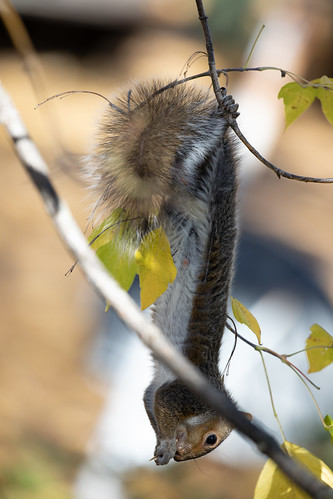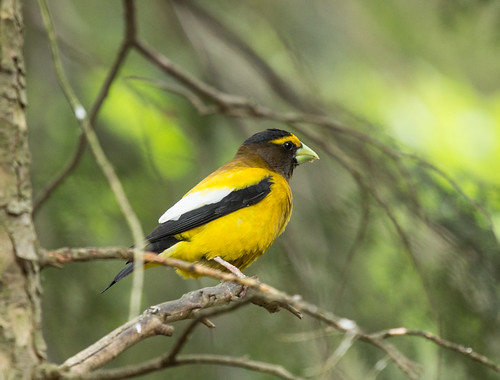2020 has been a nightmare year in a great many ways, but one saving grace for birders has been what’s called a “finch superflight.” Matthew Young, president and founder of the Finch Research Network, wrote a post about it for the American Birding Association’s Field Ornithology website:
In superflight years, the search for food will drive southward representatives from all eight species: Pine Siskin, Common Redpoll, Hoary Redpoll, Purple Finch, Pine Grosbeak, Evening Grosbeak, Red Crossbill, and White-winged Crossbill. This year, Red-breasted Nuthatches began the march in the early to mid-summer, ultimately ending up in Mexico, and then an enormous push of finches in late summer into fall began to show up at migratory hotspots like the Tadoussac Bird Observatory in Québec; the Higbee Beach Wildlife Management Area in Cape May, New Jersey; and Hawk Ridge in Duluth, Minnesota. By mid-fall, a Common Redpoll had shown up in Albuquerque, New Mexico; Evening Grosbeaks were spotted in the Florida Panhandle; Pine Siskins headed out over the ocean to Bermuda; and Hoary Redpolls visited Cleveland, Ohio.
From August through November at Hawk Ridge, just above my own neighborhood in Duluth, Pine Siskins were wonderfully abundant, with 11,542 counted. More than 2,000 White-winged Crossbills and Purple Finches flew by along with more than 1,000 Common Redpolls and Pine Grosbeaks. Sadly, even in this exceptional year, only a paltry 52 Evening Grosbeaks flew by.
Bazillions of Pine Siskins and Purple Finches visited my yard in late summer and fall. My first redpoll showed up at my feeder on October 20, and several small redpoll flocks stopped by in November, but not one since December began. And as closely as I paid attention, being home every single day because of the pandemic, I didn’t see a single Evening Grosbeak all autumn.
I’ve been yearning for flocks of Evening Grosbeaks in my yard for decades. Abundant as they were when we moved here in 1981, I haven’t seen them regularly in my yard since the mid-1990s, and the only time I had an appreciable number since the turn of the century was in 2011, starting on August 4, the morning after Russ was released from the hospital after surgery. We both slept poorly that night, and I’d have been groggy except that the very first sounds I heard when I woke up were the sweet calls of Evening Grosbeaks. I sprang from my bed, and away to the window I flew like a flash, when what to my wondering eyes should appear but a group of 16 individuals belonging to 2 or 3 family groups, the juveniles still begging from adults. They gave both of us such balm for our souls.
They went to my birdbath and my feeders, and mainly stayed in my boxelders eating bazillions of seeds.
For two weeks the flock stayed in my yard or adjacent ones virtually all the time. After August 18th or so, appearances became more sporadic, and they vanished for good in early September.
When we moved to Peabody Street in 1981, Evening Grosbeaks were a staple. I saw them at least a bit every month of the year, most abundantly from late July or August through April or May. We were going through 50 or even 100 pounds of sunflower seed every week in fall and winter. No one knows exactly why they disappeared. There are suggestions that their astonishing abundance in northern Minnesota in the 1960s through the 80s was an exceptional bump rather than normal for them, but in 1936, T.S. Roberts wrote in The Birds of Minnesota that they nest in coniferous forests of northern Minnesota and were regular in winter throughout the southern part of the state.
A lot of factors are implicated in their decrease, including pesticide applications to kill spruce budworm, which is an important food source during nesting; managing northern forests for short rotation aspens rather than the hardwoods that produce their favorite seeds; and all kinds of other problems we humans cause. Evening Grosbeaks are killed in window collisions much more than other birds, are killed by cars when drawn to roads for salt and grit, and may even have been hurt as eastern gray squirrels expanded northward. I never thought about that one until this summer. My maples and boxelders produced plenty of seeds, but squirrels devoured them all within weeks.
 |
| Squirrel eating a box elder seed |
One reliable group of grosbeaks is seen regularly in the Sax-Zim Bog each winter, but we can’t count on seeing them in other places up here.
Whatever the cause of the Evening Grosbeak’s decline up here, it remains one of my top ten birds. I’ll make at least one trip to the bog this winter in order to see them for 2021, and I’ll keep my fingers crossed that during this finch superflight, at least a few Evening Grosbeaks flying along the North Shore take it into their heads to visit my yard. That’s my New Year’s wish.



